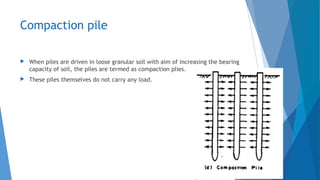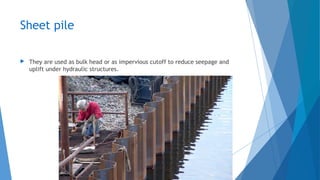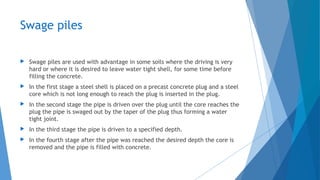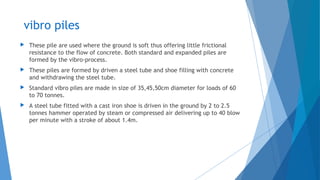Advance Construction & Equipment
- 1. Subject:- Advance Construction Equipments Subject code:- 2160601 Guided by:- Prof. Nafisha Shaikh Prof. Mihir Naik Name Enrollment No. Deshmukh Bhavik Hasmukhlal 151103106002 Kotila Jayveer Vanrajbhai 151103106008 Mistry Aditya Pramodbhai 151103106009 Pandya Dhrumil Dipakbhai 151103106010 Patel Nirmal Dalpatbhai 151103106012
- 2. Topic: Pile Foundation Outline Introduction Uses of Pile Foundation Factors affecting the selection of Type of Piles Classification of pile based on function or use Classification of pile based on Materials and composition Classification based on method of installation
- 3. Foundations Foundations are structural components used to support columns and transfer loads to the underlying Soil. 3 Foundations Isolated Combined Strap wall Raft Shallow footing footing footing footing footing Caissons Piles Deep
- 4. Introduction A pile is a slender structural member mad of steel, concrete, wood or composite material. A pile is either driven into the soil or formed in-site by excavating a hole and filling it with concrete. In case, the strata of good bearing capacity is not available near the ground, the foundation of the structure has to be taken deep with the purpose of attaining a bearing stratum which is suitable in all aspects. The most common forms of deep foundations are: Pile foundation Cassions or well foundation Cofferdams Pile cap Piles Weak soil Bearing stratum
- 5. Uses of pile foundation The load of the superstructure is heavy and its distribution is uneven. The top soil has poor bearing capacity. The subsoil water is high so that pumping of water from the open trenches for the shallow foundation is difficult and uneconomical. There is large fluctuation in subsoil water level. Where timbering to the trenches is difficult and costly. The structure is situated on the sea shore or river bed, where there is danger in scouring action of water. Canal or deep drainage lines exist near the foundation. The top soil is of expensive nature. Piles are used for the limit foundation of transmission towers, off-shore platforms which are subjected to uplift forces.
- 6. Factors affecting the selection of type of piles Nature of the structure Ground Conditions Durability Cost consideration
- 7. Nature of structure For the structures on the land, the driven and cast-in place piles are usually the cheapest for moderate loadings and unhampered site conditions. For the foundations of wharf- structures and jetties on sea shore, the driven piles or driven and cast-in –place cased piles are preferred. In case of piling is to be done very near to some existing structure, open ended tube piles or H-piles may work out to good choice. Piles used to support marine structures or structure above open water should precast type. The jacked piles are suitable for under-pinning existing structures. For heavy structure, large diameter bored piles are the most economical type.
- 8. Ground Condition If the subsoil consists of silt on alluvium for appreciable depth, the pile will act as friction pile. In case the ground is very weak or loose and it is intended to use cast-in-situ pile, casting will be required to prevent the inflow of soil into the pile hole. In adverse condition, where the ground water flow is strong, pile with permanent casing should be used. Alternatively, precast piles may be used. In case the soil strata is comparatively firm uncased cast-in-situ piles or precast pile may be selected. For reducing the length of pile in the firm strata, pedestal pile will be more effective. In situation where it is necessary that the pile should penetrate into rock for some depth, H-piles may work out to be good selection. In case the soil is firm clay, drilled piles with or without enlarged base, may work out to be a economical choice.
- 9. Durability In situation where there is possibility of the soil being chemically aggressive, high quality precast concrete piles should be selected. Timber piles may work out to be economical if they are used for the foundation of timber trestles structures with moderate loads or If the piles are to be used for protecting concrete docks, etc. Timber piles are not suitable from marine conditions as they are likely to be affected by borers or insects.
- 10. Cost Consideration While selecting a particular type of pile, the cost of pile, cost of driving, cost of maintenance of pile and availability of fund should given due consideration.
- 11. Classification based on their function or use: End bearing pile Friction pile Compaction pile Anchor pile Fender pile Sheet pile
- 12. End bearing pile These piles penetrate through the soft soil and their bottoms or tips rest on a hard stratum. These piles act as columns. The soft material surrounding the pile provides some lateral support.
- 13. Friction Pile When loose soil extends to a great depth, piles are driven up to such a depth that frictional resistance developed at the sides of the piles equal the load coming on the piles. Friction piles are used when a hard stratum is available at greater depth. The total frictional resistance can be increased in following ways: By increasing the length of pile By increasing the diameter of pile By making the surface of the pile rough By placing the piles closely By grouping the piles.
- 14. Compaction pile When piles are driven in loose granular soil with aim of increasing the bearing capacity of soil, the piles are termed as compaction plies. These piles themselves do not carry any load.
- 15. Anchor pile Anchor piles provide anchorage against horizontal pull from sheet piling or other pulling forces.
- 16. Fender pile Fender piles are used to protect water front structures against impact from ships or other floating objects.
- 17. Sheet pile They are used as bulk head or as impervious cutoff to reduce seepage and uplift under hydraulic structures.
- 18. Classification based on materials and composition Timber piles Steel piles Concrete piles Composite piles
- 19. Timber piles Timber piles are made of-tree trunks driven with small end as a point They may be circular or square. They are 30 to 50 cm in diameter with a length not exceeding 20 times its top width. At the bottom, a cast-iron shoe is provided and the top a steel plate is fixed. They have small bearing capacity and are not permanent unless treated.
- 20. Steel piles Steel piles are usually of rolled H-sections or thick pipe sections. These piles are used to withstand large impact stresses and where less distribution from driving is desired. Steel sheet piles and H-piles are generally used to support the open excavation and to provide seepage barrier.
- 21. Concrete piles Concrete piles are either precast or cast in situ. Precast piles are cast and cured at the casting site and then transported to the site for installation. These piles are adequately reinforced to with stand handling stresses along with working stresses. Precast piles are normally suitable for short lengths. Cast-in-situ piles are constructed by drilling hole in the ground and then filling the hole by concrete after placing the reinforcement.
- 23. Concrete piles There are three types 1.Pre-cast piles 2.Cast-in-situ piles 3.Prestressed piles There are two type in cast-in –situ pile 1. Cased 2. Uncased piles Raymond piles simplex piles Mac Arthur piles franki piles Monotube piles vibro piles Bsp base driven piles pedestal piles Swage piles pressure piles Button bottom piles
- 24. Pre-cast piles Pre-cast piles are those which are manufactured in factory or at a place away from construction site, and then driven into the ground at the place required. These piles require heavy pile driving machinery.
- 25. Advantages of Pre-cast concrete piles They will be cast well before the commencement of the work resulting in rapid execution of work. The position of reinforcement in pile is not disturbed from its original position. They can driven under water. The piles can be loaded soon after they have been driven to desire depth. Any numbers of piles can be manufactured at a convenient place and this may prove to be economical. These piles are highly resistant to biological and chemical actions of the subsoil.
- 26. Disadvantages of Pre-cast concrete piles These piles are heavy. Therefore they require special equipment for handling and transportation. If sufficient care is not taken, these piles may break during transport or driving. They require heavy pile driving equipment. Extra reinforcement is require to bear handling and driving stresses. Hence these piles are costly. Length
- 27. Raymond piles The Raymond standard pile is used primarily as a friction pile. It is provided with uniform taper of 1 in 30 resulting in shorter piles. The length of pile vary from 6 to 12m. The diameter of piles vary from 40 to 60 cm at the top and 20 to 30 at the bottom. the shell is driven into the ground with a collapsible steel mandrel or core in it having the same paper. The shell is gradually filled with concrete up to the top.
- 29. Mac Arthur piles Mac Arthur is a pile of uniform diameter using the corrugated steel shell which remains in place as in Raymond piles. A heavy steel casing with a core is driven into the ground. When the desired depth is reached the core is withdrawn and a corrugated steel shell is placed in the casing. Concrete is placed in the shell by gradually compacting it and withdrawing the steel casing.
- 31. Bsp base driven piles This pile consists of helically welded shell of steel plate. A concrete plug is provided at the bottom of the shell. Driving Is done by allowing pile hammer to fall on the concrete plug. The casing is driving to the desired depth and then it is filled with concrete.
- 33. Swage piles Swage piles are used with advantage in some soils where the driving is very hard or where it is desired to leave water tight shell, for some time before filling the concrete. In the first stage a steel shell is placed on a precast concrete plug and a steel core which is not long enough to reach the plug is inserted in the plug. In the second stage the pipe is driven over the plug until the core reaches the plug the pipe is swaged out by the taper of the plug thus forming a water tight joint. In the third stage the pipe is driven to a specified depth. In the fourth stage after the pipe was reached the desired depth the core is removed and the pipe is filled with concrete.
- 35. Button bottom piles These piles are used in locations where increase in the end bearing area is desired. The pile uses a concrete plug of shape of button. There piles have been used up to lengths of about 23 m and for loads up to 50 tonnes. In the 1st stage a steel pipe with 12mm thick walls is set on the concrete button. The concrete button has a diameter about 25mm larger than the pipe. In the 2nd stage the pipe and button are driven to a specified depth. In the 3rd stage a corrugated steel shell is inserted in the pipe resting on the button. In the 4th stage the casing is withdrawn leaving the button in place and the shell is filled with concrete. Reinforcement may be used if necessary.
- 37. simplex piles Simplex piles can be driven through soft or hard soils. In this type of piles a steel tube fitted with a cast iron shoe is driven into the ground up to the desired depth. Reinforcement if necessary is put inside the tube concrete is then poured into the tube and the tube is slowly withdrawn concrete being tamped leaving behind the cast iron shoe.
- 39. franki piles In this type of pile a plug of dry concrete gravel is formed on the ground by heavy removable pipe shell. A diesel operated drop hammer of 20 to 30 KN weight is driven on the concrete plug. When the tube has reduced the desired depth the tube is held in position by cables and the hammer is applied to the concrete plug forcing it down and outward. In the next stage the shaft is formed by introducing successive charges of concrete ramming each in turn and withdrawn the casing gradually about 300mm at a time. The pile diameter in franki piles vary from 50cm to 60cm while the enlarged base may have a diameter of about 90cm. The pile has a load carrying capacity of 60 to 90 tonnes.
- 41. vibro piles These pile are used where the ground is soft thus offering little frictional resistance to the flow of concrete. Both standard and expanded piles are formed by the vibro-process. These piles are formed by driven a steel tube and shoe filling with concrete and withdrawing the steel tube. Standard vibro piles are made in size of 35,45,50cm diameter for loads of 60 to 70 tonnes. A steel tube fitted with a cast iron shoe is driven in the ground by 2 to 2.5 tonnes hammer operated by steam or compressed air delivering up to 40 blow per minute with a stroke of about 1.4m.
- 43. pedestal piles This type of pile are used where thin bearing stratum is reached with reasonable depth. The core and casing are driven together into the ground till they reach the desired level. The core is taken out and a charge of concrete is placed in the tube. The core is again placed in the casing to rest on the of poured concrete. Pressure is applied on the concrete through the core and as the same time the casing is withdrawn. The process is repeated till the casing is completely removed.
- 45. pressure piles These are formed wit the help of a casing tube boring auger and compressed air equipment. These piles are especially suitable for those congested sites where heavy vibrations and noise are not permissible. A hole is bored into the ground by means of an auger and as the boring proceeds the hole is lined by a steel tube. When the tube reaches the required depth the boring tool is withdrawn. In the 2nd stage a layer of concrete is laid and pressure cap is provided at the top of the tube. The process is repeated till the pile is completed.
- 47. Composite pile A pile which is made up of two materials like concrete and timber or concrete and steel is called composite pile. Composite piles are used in situations where a part of the pile is permanently under water. The part of the pile which will be under water can be made of untreated timber and the other part can be of concrete.
- 49. Classification based on method of installation Driven piles: These piles are driven into the ground by applying blows with a heavy hammer on their tops. Timber, steel and precast concrete piles are installed by driving, which may be driven into position either vertically or at an inclination. Driven and cast-in-situ piles: These piles are formed by driving a casing with a closed bottom end into the soil. The casing is later filled with concrete. The casing may or may not be withdrawn, it is called uncased pile, and if not withdrawn, it is called cased pile.
- 50. Bored and cast-in-situ piles: These piles are formed by excavating a hole into the ground and then filling it with concrete. Screw piles: These piles are screwed into soil. Jacked piles: These piles jacked into the ground by applying a downward force with the help of a hydrolic jack.
- 51. Thank You


















































